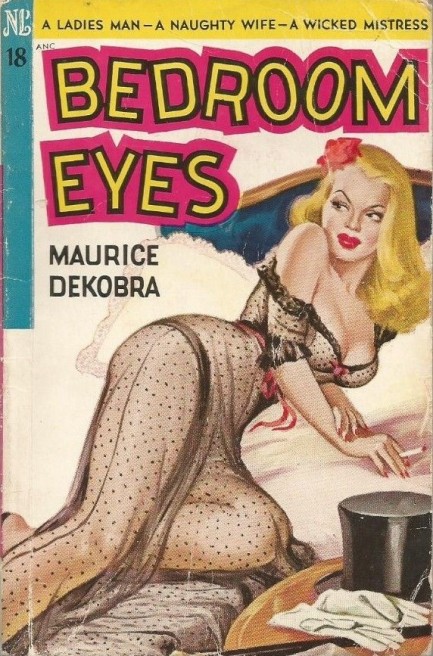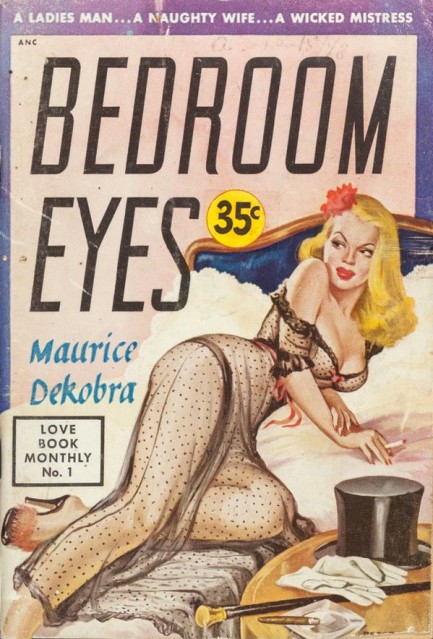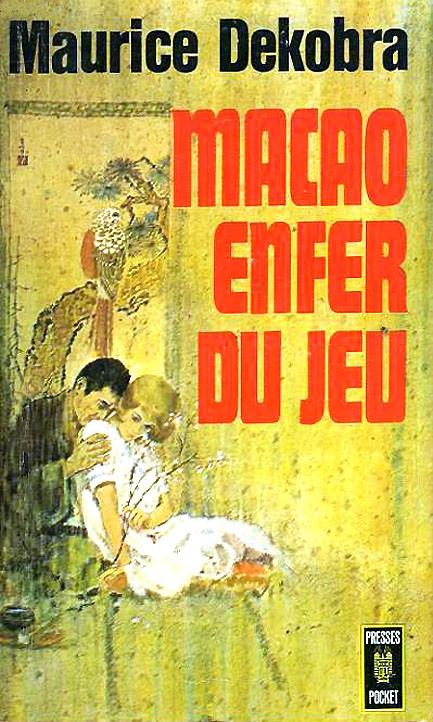 Under the circumstances you’d be singing too.  
Maurice Dekobra’s Bedroom Eyes was originally published in 1932 as La biche aux yeux cernés (which means “doe eyes identified”), and this retitled Novel Library paperback appeared in 1949 with excellent Peter Driben cover art of a nightgown-clad temptress. We can’t see her companion, but he’s left a top hat, cane and gloves in view. We think it’s Fred Astaire. Like his song from that era goes, “I just got an invitation through the mails: Your presence requested this evening. It’s formal—a top hat, a white tie, and tail…” Or, er, tails.
 Maurice Dekobra was a skilled mystery writer, but even he’d fail to solve the riddle of why he isn’t better known. Above you see an Aslan cover for the 1961 espionage novel Bouddha le terrible by French author Maurice Dekobra, who we said we’d look into a bit more. We mentioned that it’s a little embarrassing not to have known about an author who has his own adjective, and in researching his life our embarrassment grew. Born Maurice Tessier in Paris in May 1885, he studied in France and Germany, served two years in the military, and eventually launched a career as an international journalist, writing in French, English and German. He took the pseudonym Dekobra in 1908 and published his first novel Les mémoires de Rat-de-Cave in 1912. Afterward, the travel bug bit him and he took a steamer to the U.S., where for various European publications he interviewed Thomas Edison, John D. Rockefeller and other prominent Americans of the time. Upon returning to France he resumed writing fiction, and eventually broke through in 1925 with La madone des sleepings, aka Madonna of the Sleeping Cars, a novel that was translated into thirty languages and sold more than a million copies. The book made him a celebrity author, and he traveled the world in style, crossing paths with people like Errol Flynn, Marlene Dietrich, and Charlie Chaplin. He continued to publish novels, incorporating journalistic techniques in a new style that resulted in the coining of that adjective we mentioned earlier “dekobrisme”. Dekobra’s books were popular vehicles for film adaptation, and more than fifteen became movies, including his 1925 hit Macao enfer du jeu, which Clemens Klopfenstein directed in 1938. All the while Dekobra kept globetrotting—he visited India, Ceylon (now Sri-Lanka), Japan, Turkey, Pakistan, and became one of the few westerners to enter Nepal. His novels up to this point were “cosmopolites” infused with his travel experiences. For instance La madone des sleepings follows the adventures of Lady Diana Wyndham as she travels by train from London to Berlin to Russia, broke but determined to use guile and gender to make a fortune exploiting a Russian oilfield about which she’s learned. The book was developed as a film in 1928, again in 1955, and was optioned once more in the ’70s with one of our favorite women Sylvia Kristel in the lead. This third version never came to fruition, sadly, though the project reached a stage where posters were produced (and these would be quite expensive collector’s items, we suspect). experiences. For instance La madone des sleepings follows the adventures of Lady Diana Wyndham as she travels by train from London to Berlin to Russia, broke but determined to use guile and gender to make a fortune exploiting a Russian oilfield about which she’s learned. The book was developed as a film in 1928, again in 1955, and was optioned once more in the ’70s with one of our favorite women Sylvia Kristel in the lead. This third version never came to fruition, sadly, though the project reached a stage where posters were produced (and these would be quite expensive collector’s items, we suspect). In the late 1940s, Dekobra shifted literary gears and began writing pure detective novels, and he also wrote screenplays and even dabbled in film directing. Dekobra died in 1973 but it’s safe to say that he was a guy who lived to the fullest. His life and career stand as remarkable achievements—he traveled to exotic places almost unheard of in his day, met some of the most interesting people alive, and sold millions of books that were translated into seventy-seven languages. Today in Europe, he remains a twentieth century author of great renown; in the U.S. and many other countries where his books once sold well, he is virtually unknown. It’s a mystery we haven’t solved yet, but we’ll keep working on it. In the meantime, we’re happy to have finally made his acquaintance, and hope you’ll do the same. remains a twentieth century author of great renown; in the U.S. and many other countries where his books once sold well, he is virtually unknown. It’s a mystery we haven’t solved yet, but we’ll keep working on it. In the meantime, we’re happy to have finally made his acquaintance, and hope you’ll do the same.
 Maurice Dekobra invented a style of fiction that is pervasive today. 
When we saw the above book in a Paris flea market stall, we wanted it for the Aslan art. But once we looked up author Maurice Dekobra, aka Maurice Tessier, we discovered to our surprise that he was one of the most famous French writers who ever lived. Dekobra started as a subversive author in the 1920s, and pioneered a style of writing called documentary fiction, which is to say, fiction based upon factual investigation of the subject matter. Dekobra used his new techniques as he shifted into whodunits after World War II, and perfected what is now a standard operational model for mystery and thriller writers. In 1951 Dekobra, whose signature style resulted in “dekobrisme” coming into use as a French adjective, was rewarded for his extensive output with the Prix du Quai des Orfèvres literary award. It’s rather embarrassing not to have known about someone who has his own adjective, but we’ll make up for it by getting all dekobrisme and finding out more. We’ll report back later.
|
 |

The headlines that mattered yesteryear.
1947—Heyerdahl Embarks on Kon-Tiki
Norwegian ethnographer and adventurer Thor Heyerdahl and his five man crew set out from Peru on a giant balsa wood raft called the Kon-Tiki in order to prove that Peruvian natives could have settled Polynesia. After a 101 day, 4,300 mile (8,000 km) journey, Kon-Tiki smashes into the reef at Raroia in the Tuamotu Islands on August 7, 1947, thus demonstrating that it is possible for a primitive craft to survive a Pacific crossing. 1989—Soviets Acknowledge Chernobyl Accident
After two days of rumors and denials the Soviet Union admits there was an accident at the Chernobyl nuclear power plant in Ukraine. Reactor number four had suffered a meltdown, sending a plume of radioactive fallout into the atmosphere and over an extensive geographical area. Today the abandoned radioactive area surrounding Chernobyl is rife with local wildlife and has been converted into a wildlife sanctuary, one of the largest in Europe. 1945—Mussolini Is Arrested
Italian dictator Benito Mussolini, his mistress Clara Petacci, and fifteen supporters are arrested by Italian partisans in Dongo, Italy while attempting to escape the region in the wake of the collapse of Mussolini's fascist government. The next day, Mussolini and his mistress are both executed, along with most of the members of their group. Their bodies are then trucked to Milan where they are hung upside down on meathooks from the roof of a gas station, then spat upon and stoned until they are unrecognizable. 1933—The Gestapo Is Formed
The Geheime Staatspolizei, aka Gestapo, the official secret police force of Nazi Germany, is established. It begins under the administration of SS leader Heinrich Himmler in his position as Chief of German Police, but by 1939 is administered by the Reichssicherheitshauptamt, or Reich Main Security Office, and is a feared entity in every corner of Germany and beyond. 1937—Guernica Is Bombed
In Spain during the Spanish Civil War, the Basque town of Guernica is bombed by the German Luftwaffe, resulting in widespread destruction and casualties. The Basque government reports 1,654 people killed, while later research suggests far fewer deaths, but regardless, Guernica is viewed as an example of terror bombing and other countries learn that Nazi Germany is committed to that tactic. The bombing also becomes inspiration for Pablo Picasso, resulting in a protest painting that is not only his most famous work, but one the most important pieces of art ever produced.
|

|
|

It's easy. We have an uploader that makes it a snap. Use it to submit your art, text, header, and subhead. Your post can be funny, serious, or anything in between, as long as it's vintage pulp. You'll get a byline and experience the fleeting pride of free authorship. We'll edit your post for typos, but the rest is up to you. Click here to give us your best shot.

|
|





 experiences. For instance La madone des sleepings follows the adventures of Lady Diana Wyndham as she travels by train from London to Berlin to Russia, broke but determined to use guile and gender to make a fortune exploiting a Russian oilfield about which she’s learned. The book was developed as a film in 1928, again in 1955, and was optioned once more in the ’70s with one of our favorite women Sylvia Kristel in the lead. This third version never came to fruition, sadly, though the project reached a stage where posters were produced (and these would be quite expensive collector’s items, we suspect).
experiences. For instance La madone des sleepings follows the adventures of Lady Diana Wyndham as she travels by train from London to Berlin to Russia, broke but determined to use guile and gender to make a fortune exploiting a Russian oilfield about which she’s learned. The book was developed as a film in 1928, again in 1955, and was optioned once more in the ’70s with one of our favorite women Sylvia Kristel in the lead. This third version never came to fruition, sadly, though the project reached a stage where posters were produced (and these would be quite expensive collector’s items, we suspect). remains a twentieth century author of great renown; in the U.S. and many other countries where his books once sold well, he is virtually unknown. It’s a mystery we haven’t solved yet, but we’ll keep working on it. In the meantime, we’re happy to have finally made his acquaintance, and hope you’ll do the same.
remains a twentieth century author of great renown; in the U.S. and many other countries where his books once sold well, he is virtually unknown. It’s a mystery we haven’t solved yet, but we’ll keep working on it. In the meantime, we’re happy to have finally made his acquaintance, and hope you’ll do the same.





































































